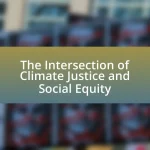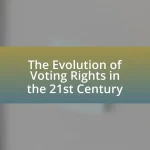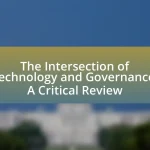The article focuses on evaluating the effectiveness of public policy in addressing climate change, highlighting the critical role that regulations, incentives, and frameworks play in promoting sustainability. It discusses how effective policies, such as carbon pricing and renewable energy mandates, can drive greenhouse gas emissions reductions and facilitate international cooperation. Key components of successful climate policies include regulatory frameworks, economic incentives, public engagement, and the integration of scientific research. The article also addresses the challenges in evaluating policy effectiveness, including data limitations and biases, while emphasizing best practices such as adaptive management and stakeholder involvement to enhance evaluation processes.
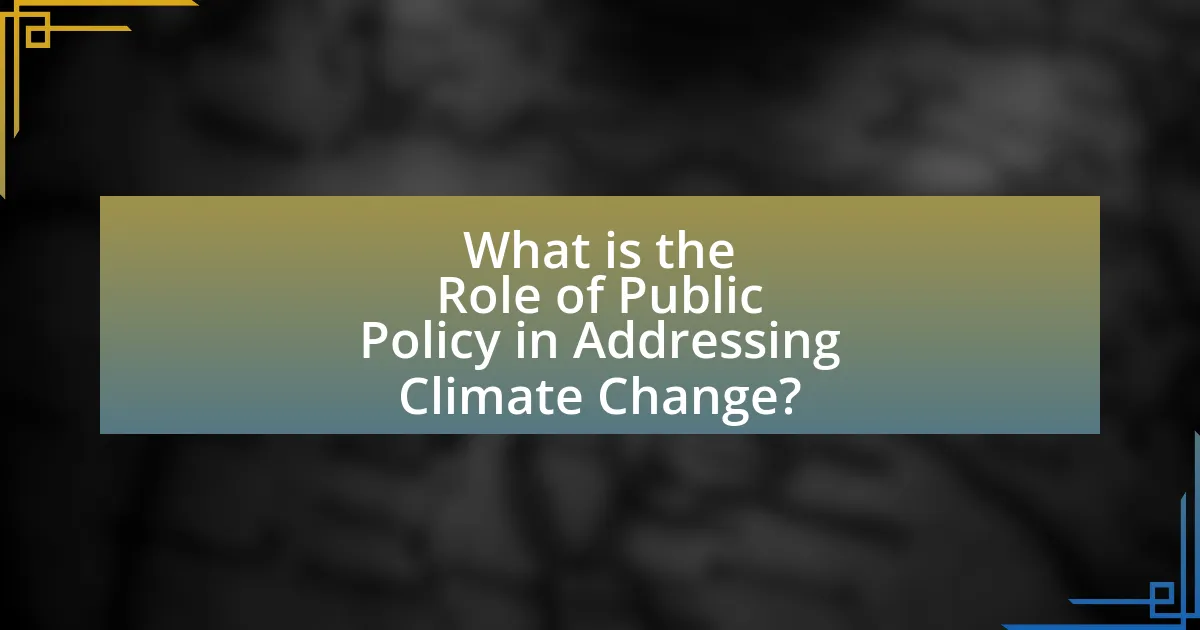
What is the Role of Public Policy in Addressing Climate Change?
Public policy plays a crucial role in addressing climate change by establishing regulations, incentives, and frameworks that guide societal behavior towards sustainability. Effective public policies, such as carbon pricing and renewable energy mandates, incentivize reductions in greenhouse gas emissions and promote the transition to clean energy sources. For instance, the implementation of the Clean Power Plan in the United States aimed to reduce carbon emissions from power plants, demonstrating how regulatory measures can lead to significant decreases in pollution levels. Additionally, public policies can facilitate international cooperation, as seen in agreements like the Paris Accord, which unites countries in their commitment to limit global warming. These policies are essential for mobilizing resources, driving innovation, and ensuring accountability in climate action efforts.
How do public policies influence climate change mitigation efforts?
Public policies significantly influence climate change mitigation efforts by establishing regulatory frameworks, incentivizing sustainable practices, and allocating funding for green technologies. For instance, policies such as carbon pricing create economic incentives for businesses to reduce emissions, while renewable energy mandates encourage the adoption of clean energy sources. Evidence from the International Energy Agency indicates that countries implementing stringent climate policies have seen a marked decrease in greenhouse gas emissions, demonstrating the effectiveness of such measures in driving climate action.
What are the key components of effective climate change policies?
Effective climate change policies consist of regulatory frameworks, economic incentives, public engagement, and scientific research integration. Regulatory frameworks establish legally binding emissions targets and standards, which are essential for accountability. Economic incentives, such as carbon pricing and subsidies for renewable energy, encourage businesses and individuals to reduce their carbon footprint. Public engagement ensures community support and participation, which is crucial for the successful implementation of policies. Finally, integrating scientific research into policy-making allows for evidence-based decisions that adapt to new findings and technologies, enhancing the overall effectiveness of climate strategies.
How do these components interact to drive climate action?
Components such as government policies, public awareness, and technological innovation interact synergistically to drive climate action. Government policies establish regulatory frameworks and incentives that encourage sustainable practices, while public awareness mobilizes community support and individual behavioral changes. Technological innovation provides the necessary tools and solutions to reduce emissions and enhance energy efficiency. For instance, the implementation of carbon pricing by governments has been shown to reduce greenhouse gas emissions significantly, as evidenced by a study from the World Bank, which reported that countries with carbon pricing mechanisms saw a 20% reduction in emissions over a decade. This interplay among policies, awareness, and technology creates a comprehensive approach that effectively addresses climate change challenges.
Why is evaluating public policy effectiveness crucial for climate action?
Evaluating public policy effectiveness is crucial for climate action because it ensures that strategies implemented to combat climate change are achieving their intended outcomes. Effective evaluation allows policymakers to assess the impact of regulations, funding allocations, and initiatives on greenhouse gas emissions and environmental sustainability. For instance, a study by the Intergovernmental Panel on Climate Change (IPCC) highlights that countries with robust evaluation frameworks are more likely to meet their climate targets, as they can adapt and refine policies based on empirical evidence. This iterative process of evaluation and adjustment is essential for maximizing the efficacy of climate action efforts.
What metrics are used to assess the effectiveness of climate policies?
Metrics used to assess the effectiveness of climate policies include greenhouse gas emissions reductions, energy consumption changes, and economic impacts. Greenhouse gas emissions reductions are measured in metric tons of CO2 equivalent, providing a direct indication of a policy’s success in mitigating climate change. Energy consumption changes are evaluated through shifts in renewable energy usage versus fossil fuels, reflecting the transition towards sustainable energy sources. Economic impacts are assessed by analyzing job creation in green sectors and the cost-effectiveness of implemented policies, often measured through cost per ton of emissions reduced. These metrics collectively provide a comprehensive evaluation of climate policy effectiveness.
How can stakeholder feedback improve policy evaluation?
Stakeholder feedback can significantly enhance policy evaluation by providing diverse perspectives that inform the assessment process. Engaging stakeholders, such as community members, experts, and affected parties, allows policymakers to gather insights on the real-world impacts of policies, ensuring that evaluations reflect actual experiences and needs. For instance, a study by the National Academy of Sciences found that incorporating stakeholder input leads to more relevant and effective policy adjustments, as it highlights areas of concern that may not be evident through quantitative data alone. This feedback loop fosters transparency and accountability, ultimately resulting in policies that are better aligned with the goals of addressing climate change effectively.
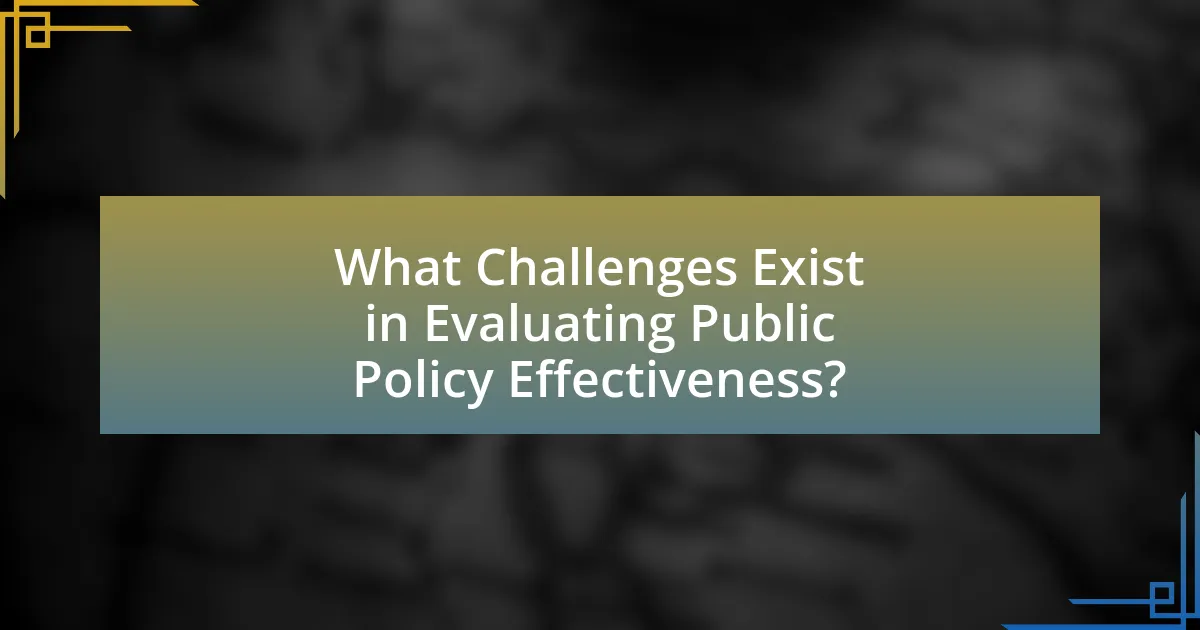
What Challenges Exist in Evaluating Public Policy Effectiveness?
Evaluating public policy effectiveness faces several challenges, including the complexity of measuring outcomes, the influence of external factors, and the difficulty in establishing causality. The complexity arises from the multifaceted nature of public policies, which often have numerous objectives and stakeholders, making it hard to isolate specific impacts. External factors, such as economic conditions or social changes, can also skew results, complicating the assessment of a policy’s direct effects. Furthermore, establishing causality is challenging because multiple policies may interact simultaneously, making it difficult to determine which specific policy led to observed changes. These challenges are evident in studies like the 2020 report by the National Academy of Sciences, which highlights the intricacies involved in attributing climate change mitigation outcomes to specific policies.
What are the common obstacles in measuring policy outcomes?
Common obstacles in measuring policy outcomes include data availability, attribution challenges, and the complexity of environmental systems. Data availability is often limited due to insufficient monitoring systems or lack of comprehensive datasets, making it difficult to assess the impact of policies accurately. Attribution challenges arise when trying to isolate the effects of specific policies from other influencing factors, such as economic changes or natural variability. Additionally, the complexity of environmental systems complicates the measurement process, as multiple interrelated variables can affect outcomes, making it hard to establish clear cause-and-effect relationships. These obstacles hinder effective evaluation and can lead to misinterpretation of policy effectiveness in addressing climate change.
How do data limitations affect policy evaluation?
Data limitations significantly hinder policy evaluation by restricting the availability and quality of information necessary for assessing the effectiveness of public policies. When data is incomplete, outdated, or biased, it leads to inaccurate conclusions about policy impacts, making it difficult to determine whether a policy is achieving its intended outcomes. For instance, a lack of longitudinal data can prevent the analysis of long-term effects of climate policies, while insufficient geographic data may obscure regional disparities in policy effectiveness. Consequently, these limitations can result in misguided policy decisions, as stakeholders may rely on flawed evaluations that do not accurately reflect the realities of climate change impacts and responses.
What role does political influence play in the evaluation process?
Political influence significantly shapes the evaluation process of public policy by determining priorities, resource allocation, and the interpretation of data. Policymakers often rely on political agendas to guide which policies are assessed and how their effectiveness is measured, leading to potential biases in evaluation outcomes. For instance, in climate change policy, political support can dictate the emphasis on certain metrics, such as emissions reductions versus economic impacts, thereby influencing public perception and funding decisions. Research indicates that political considerations can lead to selective reporting of evaluation results, as seen in various governmental assessments where favorable outcomes are highlighted to support ongoing initiatives.
How can biases impact the evaluation of climate policies?
Biases can significantly distort the evaluation of climate policies by influencing the interpretation of data and the prioritization of certain outcomes over others. For instance, confirmation bias may lead evaluators to favor evidence that supports pre-existing beliefs about a policy’s effectiveness while disregarding contradictory data. This can result in skewed assessments that overlook critical factors such as long-term environmental impacts or socioeconomic consequences. Research indicates that cognitive biases, such as anchoring bias, can also affect decision-making processes, causing evaluators to rely too heavily on initial information rather than considering a broader range of evidence. Consequently, these biases can hinder the development of effective climate strategies and impede progress toward sustainability goals.
What are the types of biases that can occur during evaluation?
Types of biases that can occur during evaluation include confirmation bias, selection bias, and attribution bias. Confirmation bias occurs when evaluators favor information that confirms their pre-existing beliefs, potentially skewing the assessment of public policy effectiveness. Selection bias arises when the sample evaluated is not representative of the broader population, leading to inaccurate conclusions about policy impacts. Attribution bias involves misattributing outcomes to specific policies without considering other influencing factors, which can distort the evaluation of climate change initiatives. These biases can significantly affect the reliability of evaluations in public policy contexts.
How can evaluators mitigate these biases?
Evaluators can mitigate biases by implementing structured evaluation frameworks that emphasize objectivity and transparency. These frameworks often include standardized criteria for assessment, which help reduce subjective interpretations and ensure consistency across evaluations. Research indicates that using multiple evaluators can further minimize individual biases, as diverse perspectives contribute to a more balanced assessment. Additionally, training evaluators on recognizing and addressing their own biases can enhance awareness and improve decision-making processes. For instance, studies have shown that evaluators who undergo bias training are more likely to identify and correct for biases in their evaluations, leading to more accurate outcomes.

What Best Practices Can Enhance the Evaluation of Climate Policies?
Best practices that can enhance the evaluation of climate policies include establishing clear, measurable objectives, utilizing robust data collection methods, and engaging stakeholders throughout the evaluation process. Clear objectives allow for specific benchmarks to assess progress, while robust data collection ensures that evaluations are based on accurate and comprehensive information. Engaging stakeholders, including affected communities and experts, fosters transparency and inclusivity, which can lead to more relevant and effective evaluations. Research indicates that policies with well-defined goals and stakeholder involvement are more likely to achieve desired outcomes, as seen in the evaluation of the European Union’s climate policies, which emphasize stakeholder engagement and measurable targets.
How can adaptive management improve policy evaluation?
Adaptive management can improve policy evaluation by enabling a systematic approach to learning and adjusting policies based on real-time feedback and outcomes. This iterative process allows policymakers to assess the effectiveness of climate change initiatives continuously, making necessary adjustments to enhance their impact. For instance, studies have shown that adaptive management frameworks, such as those implemented in natural resource management, lead to more effective policy outcomes by incorporating stakeholder input and scientific data, thereby increasing the resilience of policies to changing environmental conditions.
What are the steps involved in implementing adaptive management?
The steps involved in implementing adaptive management include defining clear objectives, assessing the current situation, developing management strategies, implementing those strategies, monitoring outcomes, and adjusting management practices based on feedback.
Firstly, defining clear objectives establishes the goals of the management process, ensuring that all stakeholders understand the desired outcomes. Secondly, assessing the current situation involves gathering data on existing conditions and challenges, which informs the development of effective management strategies.
Next, developing management strategies entails creating specific actions or interventions aimed at achieving the defined objectives. Following this, implementing those strategies puts the plans into action, requiring coordination among stakeholders.
Monitoring outcomes is crucial as it involves collecting data to evaluate the effectiveness of the implemented strategies. Finally, adjusting management practices based on feedback allows for continuous improvement, ensuring that the management approach remains relevant and effective in addressing changing conditions.
This iterative process is essential for effective public policy in addressing climate change, as it allows for flexibility and responsiveness to new information and environmental changes.
How does adaptive management contribute to ongoing policy effectiveness?
Adaptive management enhances ongoing policy effectiveness by allowing for iterative learning and adjustment based on real-world outcomes. This approach enables policymakers to respond dynamically to changing environmental conditions and stakeholder feedback, ensuring that policies remain relevant and effective over time. For instance, in the context of climate change, adaptive management has been applied in various ecosystems, such as the Everglades restoration project, where continuous monitoring and adjustments have led to improved ecological outcomes and resource management. This evidence demonstrates that adaptive management not only facilitates better decision-making but also fosters resilience in policy frameworks, ultimately leading to more effective responses to climate challenges.
What role does public engagement play in effective policy evaluation?
Public engagement is crucial for effective policy evaluation as it enhances transparency, accountability, and inclusivity in the decision-making process. Engaging the public allows policymakers to gather diverse perspectives, which can lead to more comprehensive assessments of policy impacts. For instance, studies have shown that public input can identify unintended consequences of policies, thereby improving their design and implementation. Research by the International Association for Public Participation indicates that policies developed with public involvement are more likely to be accepted and successfully implemented, demonstrating the importance of public engagement in achieving effective policy outcomes.
How can public participation enhance the evaluation process?
Public participation can enhance the evaluation process by incorporating diverse perspectives and local knowledge, which leads to more comprehensive assessments. Engaging the public allows for the identification of community-specific issues and priorities, ensuring that evaluations reflect the actual impacts of policies on different populations. Research indicates that participatory evaluation methods can improve the accuracy of data collected, as seen in studies like “The Role of Public Participation in Environmental Decision-Making” by the National Research Council, which highlights that stakeholder involvement often results in more relevant and actionable insights. This collaborative approach not only fosters transparency but also builds trust between policymakers and the community, ultimately leading to more effective climate change policies.
What strategies can be employed to increase public involvement?
To increase public involvement in addressing climate change, strategies such as community engagement initiatives, educational campaigns, and participatory decision-making processes can be employed. Community engagement initiatives, like local workshops and forums, allow citizens to voice their concerns and contribute ideas, fostering a sense of ownership over climate policies. Educational campaigns that raise awareness about climate change impacts and solutions can motivate individuals to participate actively. Participatory decision-making processes, where the public is involved in policy formulation, enhance transparency and trust, leading to greater public commitment. Research indicates that communities with higher levels of public engagement in environmental issues report more effective climate action outcomes, demonstrating the importance of these strategies.
What are the key takeaways for evaluating public policy effectiveness in climate change?
Key takeaways for evaluating public policy effectiveness in climate change include establishing clear, measurable objectives, assessing the implementation process, and analyzing outcomes against baseline data. Clear objectives allow for targeted interventions, while a thorough implementation assessment ensures policies are executed as intended. Analyzing outcomes against baseline data, such as greenhouse gas emissions levels or temperature changes, provides concrete evidence of policy impact. For instance, the effectiveness of the Paris Agreement can be evaluated by tracking national commitments to reduce emissions and their actual performance over time, demonstrating the importance of data-driven evaluation in understanding policy success.
How can policymakers apply evaluation findings to improve future policies?
Policymakers can apply evaluation findings to improve future policies by systematically analyzing the outcomes of previous initiatives and integrating lessons learned into the design of new policies. For instance, if an evaluation reveals that a specific climate policy led to a significant reduction in carbon emissions, policymakers can replicate and scale that approach in future legislation. Additionally, evaluations can identify gaps or unintended consequences, allowing policymakers to adjust strategies proactively. Research from the National Academy of Sciences indicates that evidence-based policymaking enhances the effectiveness of climate initiatives by ensuring that decisions are informed by data and real-world impacts. This approach not only fosters accountability but also builds public trust in governmental actions aimed at addressing climate change.
What resources are available for best practices in policy evaluation?
Resources available for best practices in policy evaluation include the “Guidelines for Evaluating Climate Change Adaptation Projects” by the United Nations Development Programme, which provides a framework for assessing the effectiveness of adaptation initiatives. Additionally, the “Evaluation Framework for Climate Change Adaptation” published by the World Bank offers methodologies and tools for evaluating climate-related policies. The “OECD Evaluation Criteria” document outlines key principles for evaluating public policies, emphasizing relevance, effectiveness, efficiency, and sustainability. These resources are widely recognized and utilized by policymakers and evaluators to ensure rigorous assessment of climate change policies.



